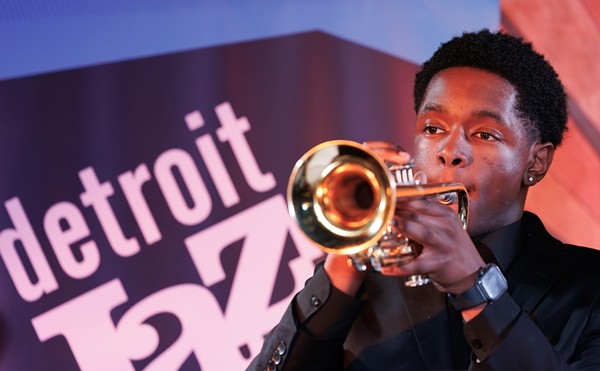"You're listening to the Ed Special show and today's topics will be, let's see, what is music, God and hallucinogens, three out of four food groups," he intones to the airwaves.
Special, who has made audio collage art on radio on WCBN for 14 years is decidedly not your average jock. His "Special Ed" show is, rather, a juxtaposition of snippets of recorded audio cultural history (you know, the records that fall into the "other" category), tape loops, washes of disorienting noise and soundscapes and other aural flotsam that, from behind the control board, he orchestrates into an on-air symphony of humor, cultural criticism and general wackiness that demands the listener both pay attention and engage atrophied listening synapses.
The show occupies a fringe area of radio that pays no heed to demographic research and seeks, more than anything, to shake the listener out of the bland, heavy rotation doldrums that take up the rest of the dial. And Special's not alone. Direct connections can be made between his show and the work of sonic outlaw media collective Negativland (famous for its 1991 record U2 and the ensuing lawsuit-documentation-as-cultural-criticism, which managed to skewer both DJ Casey Kasem and the Irish pop group with a collage reworking of U2's hit "I Still Haven't Found What I'm Looking For") and Emergency Broadcast Network, which creates "culture jamming" art by rearranging mainstream advertising media to comment on itself.
Turntable cut-and-paste pioneer Christian Marclay and cellular phone pirate and ambient artist Scanner pave similar roads into astute record consumer culture. Yet Special's on-air art draws as much from Orson Welles' "Theater of the Air" broadcast tradition of the 1940s as any multimedia dadaist exercises. So it is framed in these seemingly disparate traditions that we can find Special spanning the disciplines and manning the tape loops and turntables.
There is no typical Ed Special show, but listeners who tune into his program (noon-5 Tuesdays) hear his self-produced tapes (complete with one-of-a-kind cover artwork by Special) or participate in the "Nu Clear Leader" portion of the annual Ann Arbor Film Festival (where filmgoers are invited to draw on clear leader reels which are then screened, accompanied by an improvised Ed Special audio backdrop), and can count on hearing new, exciting connections made between old, familiar or clichéd sounds.
"Snippets of tape that are otherwise completely unrelated take on a new meaning when you combine them in a certain way," says Special.
"Recontextualizing is a good way of looking at it. It's a great venue for social criticism, too. It can be a lot easier to take for the listener and a lot more entertaining than straight commentary. I like to think of it as infotainment, or even irritainment."
Some of the topics that Special's shows have tackled are Christmas holiday consumerism, the cultural fascination with mass cult suicides, alien abduction and even smoking. "I like to tie my shows to a particular event so that, conceptually, the events come with instructions.
"You can take old science recording samples and very serious social criticism pieces and put it all together and it can be very entertaining. But it can also piss people off."
The fact that the messenger enjoys crafting and delivering the message is the enduring charm of this form for Special.
"Part of what keeps me going is pissing people off all the time. If you're tuning in, we're going to fuck with you. And we're going to fuck with you for five hours!" he says laughing.
Indeed, radio is a unique canvas that's very seldom fully explored. "Radio is a way that you can present art, but it's a space without walls," says onetime Special collaborator and fellow audio collage aficionado John Mosher.
"A lot of people would think that radio is limited because you don't have the visual aspect. I think the opposite is true. You can play things that are audio stimuli that'll bring up certain images and emotions that you can't pull off on TV or other electronic media."
The nuts and bolts of the machine that is an audio collage show are as mundane as 10 hours of pre-editing, splicing, recording samples off the television and listening to a lot of records for, maybe, 10 seconds worth of material. But what comes out the speakers once the puckish aural manipulators hit the air is often as sublime as any jazz solo. Indeed, Special's programs seem to follow Dizzy Gillespie's edict, "It's not what you do play, but what you don't."
"When I was doing radio with Ed, it was very similar to the experience I have playing music. Like musicians will work with a group of people, each having their own instrument, we would work within our own studio without talking to each other. But the instruments we use are turntables and cassette decks," says Mosher.
Audio collage, besides having one foot in the radio theater tradition, has a lot in common with the techno and noise communities, both of which have put Detroit on the musical map in the past 10 years. "It's a commonality in the art form," says Mosher.
"Techno deejays don't just go out and play records. They count beats per minute; they mix records and perform turntable wizardry. And the noise artists are out there doing live performance -- essentially improvising a collage of sounds. So there's a big tie-in."
This sort of radio collage is almost always tackled on small, community-based radio stations. But according to Special, that's part of the romance. "These signals are hard to get and you might have to drive somewhere to get it. It's out there in the ether and it's small and you gotta work for it. But when you get it, there's your reward."
"Unlike regular radio where you have deejays playing records, this is a radio that's really alive," says Mosher.
"The typical radio format doesn't leave you anything really to work with," adds Special.
To illustrate the point, Mosher says, "How many other radio stations in the world would allow their deejays to do a 27-hour radio show that tackled the history of the universe?" Which begs the question: How exactly do listeners respond to this sort of media therapy?
"I get a lot of calls from people who want copies of, say, my Easter show, which was about the Dead Sea scrolls, and find them very, very intriguing and stimulating. And then there's the people who say, 'What is this fucking bullshit?' " he says.
"I got a call one time at 5 in the morning when I was doing a show. ... It was some irate listener saying, 'You know, no one's listening to this.' And I said, 'Well, you are,' " laughs Special.
"If I were in the audience, I'd want to hear this. I get (typical programming) rammed down my ear everywhere I go. When I'm put on hold trying to explain why my electric bill is late, wherever, I can't escape it. I'm providing a service for people who want to hear this. If you don't like it, do what I would do if this other stuff was on the air: Turn it off." Chris Handyside is a freelance writer for Metro Times. Send comments to [email protected]





